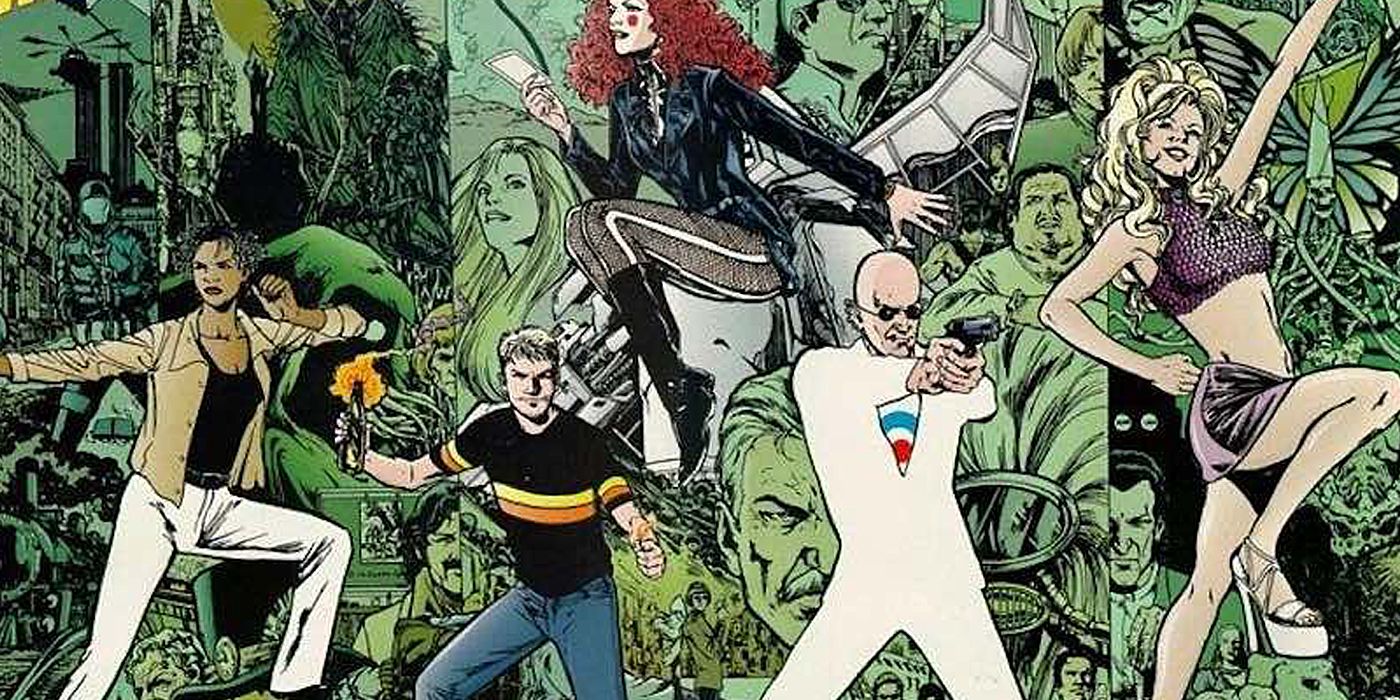WARNING: This article contains spoilers for The Invisibles, on sale now.
Scottish writer Grant Morrison spent the '80s and early '90s bringing his particular sense of superheroes to numerous corners of the DC Comics universe. Arkham Asylum and Batman: Gothic heightened the strangeness of the Caped Crusader’s world, while Animal Man and Doom Patrol elevated B-list heroes at the same time as discussing art, trauma, family and the very nature of comics themselves. These series shared an aesthetic that, in conjunction with Morrison's fellow British creators, ultimately led to the creation of DC’s successful Vertigo imprint. After a brief break upon completing Doom Patrol, Morrison returned to DC and Vertigo with a much bigger idea: The Invisibles.
Released in 1994, The Invisibles took everything Morrison’s previous superhero works had dealt with and turned the volume up to 11 (to use a Spinal Tap metaphor). The series ran 6 years, producing 59 issues and 2 short stories, and followed a cast of characters intertwined in the conspiratorial battle between the Invisible College and the Outer Church.
Morrison has always been very clear that The Invisibles is more than just an adventure comic. He’s called it a spell, a machine for creating Invisibles. In his closing remarks in volume 3, issue #1, he says of the series, “Things happen around it and to the people who absorb it.” But, 25 years later, what kind of impact has this mind-bending hypersigil (his description) had?
When The Matrix hit movie screens in 1999, controversy followed, as some shots from the film reproduced moments from the comics almost to a fault. Though Morrison initially reacted adversely to this revelation, his attitude shifted to one of acceptance, as one of the primary motivations for The Invisibles was to disseminate the philosophy to a wider audience. The Matrix, whether movie-goers were aware of it or not, accomplished this. In fact, in thinking about the continuing legacy of the series, The Matrix is an excellent starting point.
Midway through the second volume of the series, Mason Lang, explicitly an Invisibles-universe version of Bruce Wayne, pontificates on what we might call “Invisible Art:” “It means, basically, that some movies are clearly being made by Invisibles and they contain messages for other Invisibles. Invisibles talking to each other in their own secret language…” Although potentially off-putting at first Invisible Art, the real legacy of the series, is created by and for those who, as Morrison noted, absorbed the series, those who internalized the series' lessons of tolerance, activism and perseverance. The Matrix is only the first of these communications from other Invisibles.
Another potential example of Invisible Art comes from My Chemical Romance’s 2012 album The Black Parade. Lead singer Gerard Way is acquainted with Grant Morrison, and Morrison appeared as a villain in videos from the band’s follow-up album Danger Days. More than anything it is the relationship between the two that suggests that the lyrics from “Teenagers” are drawing on The Invisibles, specifically the very first issue of the series. The lyrics to “Teenagers” go, “They gonna rip up your heads / Your aspirations to shreds / Another cog in the murder machine.” Comparatively, the comic sees Dane McGowan in Harmony House, a juvenile rehabilitation facility. After gathering with the rest of the inmates, Mr. Gelt, the director of the facility, gives a speech mirroring the lyrics of the song, as he tells the young offenders that they’ll be made to “have pride in [their] role as a cog in the great machine of society.”
If this seems a tenuous connection, we can also look at the landscapes of the music videos from The Black Parade which look very much like the landscape of the Archons’ universe in The Invisibles.
Stranger Things also referenced the series in a Season 2 episode titled “The Lost Sister.” Although the episode has come under fire for being unimportant to the season overall, this reference communicates a great deal of information to those in the know. Kali’s group of misfits mirrors the main Invisibles group quite literally: A streetwise African-American woman, an anarchic punk rocker, a mysterious woman with mental powers, and a new recruit with untested and uncharted powers.
Further, on the walls of the warehouse within which the team resides are names of various members of the Invisibles, including Tom O’Bedlam and King Mob. In The Invisibles, the series gives readers glimpses of other Invisibles cells aside from the main group. The takeaway from this episode is that the the horrors happening in Hawkins are not relegated solely to that small town. This is a struggle that has a much farther flung reach.
Although it's been a generation since Morrison's series debuted, contemporary creators are still drawing on his work. The current Doom Patrol television series involves Flex Mentallo, a character whose mini-series mirrors many of the concerns of The Invisibles, including fourth wall-breaking and considerations of writing oneself into a narrative. These tributes reference Morrison's Invisible Art, and attempt to communicate something to those in the know.
Of course, to be in the know you'd have to read Morrison's The Invisibles.

